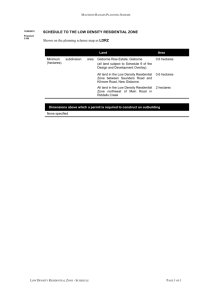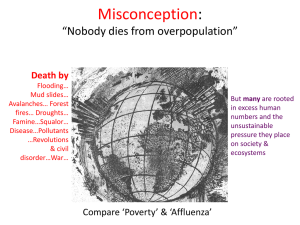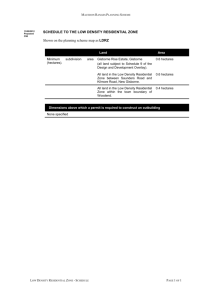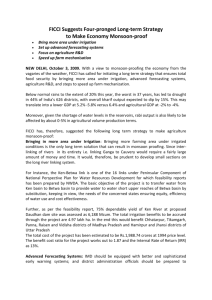Relevant GEF-6 Programmes under Biodiversity Focal area for
advertisement
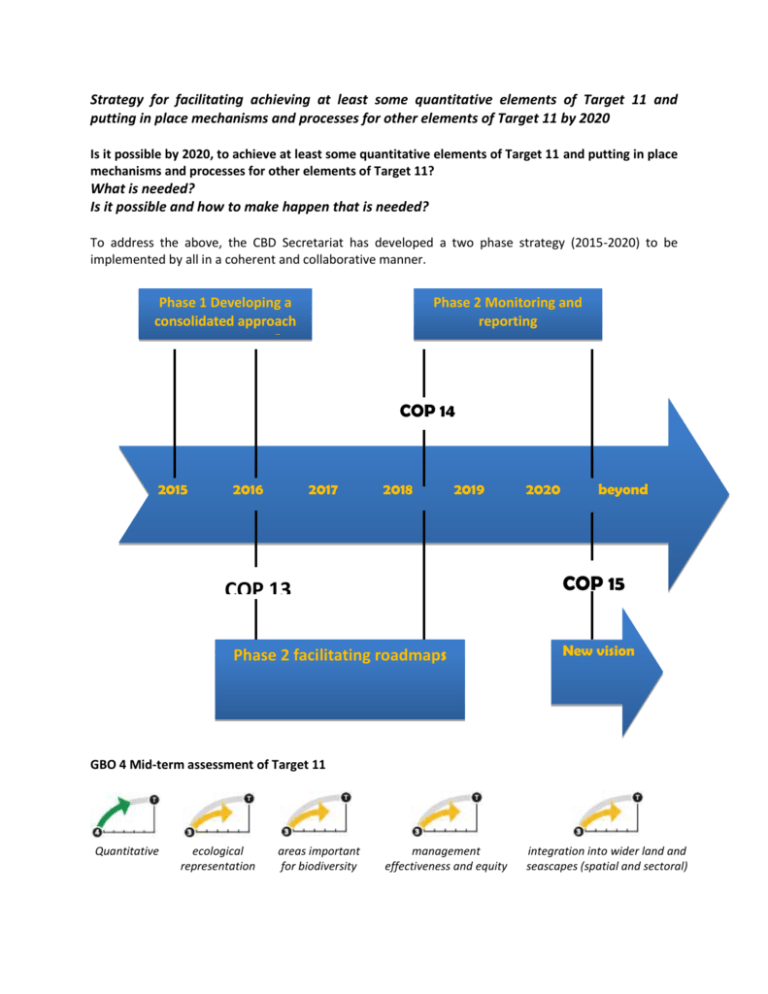
Strategy for facilitating achieving at least some quantitative elements of Target 11 and putting in place mechanisms and processes for other elements of Target 11 by 2020 Is it possible by 2020, to achieve at least some quantitative elements of Target 11 and putting in place mechanisms and processes for other elements of Target 11? What is needed? Is it possible and how to make happen that is needed? To address the above, the CBD Secretariat has developed a two phase strategy (2015-2020) to be implemented by all in a coherent and collaborative manner. Phase 1 Developing a consolidated approach Phase 2 Monitoring and reporting appapproach COP 14 2015 2016 2017 2018 2019 2020 beyond COP 15 COP 13 Phase 2 facilitating roadmaps New vision GBO 4 Mid-term assessment of Target 11 Quantitative ecological representation areas important for biodiversity management effectiveness and equity integration into wider land and seascapes (spatial and sectoral) The green indicates quantitative global targets of 17% terrestrial and 10% marine. The three yellow are management effectiveness, ecological representation and integration into wider land- and seascapes. Green indicates that the element is on track and with continued efforts this aspect of the target will be achieved by the target date of 2020; yellow means there is progress but it is not sufficient to achieve this aspect of the target. What is the status of target 11 at global level? Quantitative aspects: 15.4% of terrestrial and 8.4% of marine (within national jurisdiction-200 nautical miles) is under protection. Ecological representation: 650 terrestrial and 150 marine ecological regions have more than 10% protection each. Areas important for biodiversity: about 250 Alliance Zero Extinction sites and 700 important bird areas are under protection. Effective management: about 30% of worlds protected areas have effective management What is needed for achieving the Target 11 at global level by 2020? Quantitative aspects: 1.6% or 2.2 million KM2 of terrestrial and marine areas are needed to be protected. Ecological representation: in about 200 terrestrial ecological regions and in 100 marine ecological regions the existing protection status has to be improved to reach 10% protection of that ecological region at global level. Areas important for biodiversity at minimum level: 250 AZE areas and 200 Important Bird Areas in Danger need to be brought under protection. Effective management: at least another 30% of protected areas have to be brought under effectively managed category. Phase 1 (2015-2016)Developing a Consolidated Approach and collecting information on status, gaps and opportunities for each element and focused priority actions to be undertaken in next five years in the form of road maps for presenting to COP 13. In the first step, the Secretariat has renewed communications with a number of organizations from the PoWPA Friends Consortium. In the second step, in order to help Parties collect and share information and data on the status of the target, the Secretariat of the CBD has prepared 184 country dossiers on Target 11 using information from BirdLife International, the Digital Observatory for Protected Areas, and the World Database of Protected Areas as per notification dated March 9, 2015. The dossiers include: Terrestrial and Marine Ecoregions (ER) Important Bird and Biodiversity Areas (IBAs) Alliance for Zero Extinction Sites (AZEs) Overlaps between unprotected and partially protected IBAs and AZEs and candidate ER for further protection Actions identified in their PoWPA Action Plan, Fifth National Report, or NBSAP Allocation and utilization of their Fifth and Sixth replenishment of the Global Environment Facility (GEF) The country data dossiers are in no way prescriptive: they are intended to help Parties identify the status of different elements of the target and actions they can undertake in the next five years. The dossiers were shared with respective country representatives of the regional workshops for validation and updating of information. Thus far, these dossiers have helped the Secretariat to compile the regional, sub-regional and global-level status of the targets. In the third step, the Secretariat has developed a series of four e- mail communications to prepare country participants for the workshop. 3826 The first email describes background, objectives of workshop and the process. The second email presents the country data dossier and the information contained within it, the objectives behind compiling it and asks the participant to go through it for validation, updating as well as its usefulness in identifying the gaps. The third email presents a questionnaire that requests the participants to fill and submit by a due date taking into account information in the dossier as well as other relevant information in consultation with CBD and PoWPA Focal points and other relevant colleagues. The fourth communication, requests the participants to report on the status of each element of target 11 including gaps and opportunities in the form of a matrix. Participants are also requested in this e mail to identify and list priority, feasible and focused actions, taking into account gaps, opportunities and commitments in NBSAP or PoWPA action plan etc., which they would undertake in next five years whose implementation improve the existing status by 2020 and facilitate achieving the target at national, regional or global levels. In order to help country representatives for this purpose , their attention was invited to the ongoing or just approved GEF 5 PA projects and other bilateral projects and requested them to track the projects to the elements of target 11( see the example of Colombia below) Colombia Designing and Implementing a National Sub-System of Marine Protected Areas (SMPA) Biodiversity UNDP FP 4,850,000 7,500,000 Under Implementation 3886 Colombia Colombian National Protected Areas Conservation Trust Biodiversity World Bank FP 4,000,000 13,800,000 IA Approved The German Government through BMZ, BMUB, KFW and IKI approved the following PA related projects: When needed country representatives are also engaged in conference calls to clarify the doubts and explain the process and requirements. Participants are requested asked to bring all this information to the workshop. In the fourth step, the workshop, participants share the information they have collected from the communications. They submit a table of the status, gaps and opportunities for Aichi Target 11 and draft identified actions (roadmap) to be undertaken in the next five years which will make a change to the existing status at national, regional and global levels. Participants are requested to submit their final matrices and priority actions (road maps) after further scrutiny, aligning with GEF 6 and other bilateral projects etc., formally through their CBD focal points. The results of the two regional workshops held so far are very encouraging. All 36 countries submitted their status Matrices and draft priority actions. Mexico draft status matrix and priority actions attached for reference. Proposed draft actions from seven Latin American countries (Argentina, Brazil, Chile, Colombia, Costa Rica, Mexico and Uruguay per se are contributing to increase 2.1 % increase in terrestrial protected Areas at GRULAC level which adds 0.3% at global level). Reaching out to all countries covering all five UN regions for collecting the status and priority actions and then facilitate their implementation will have immense potential towards achieving at least some quantitative elements of Target 11 and putting in place mechanisms and processes for other elements of Target 11 and elements of Target 12. In the last step, the information collected at the workshop will be used for reporting the regional, sub-regional and global-level status of the different elements of target 11 at sub-regional, regional and global levels to COP 13. In addition, information from the actions formally submitted can be compiled to assess what will be the regional, sub-regional and global-level increases of the different elements of target 11 at COP 13; this projection will give us an idea of which elements will be achieved. Furthermore, the actions formally submitted for a national roadmap for implementation, which can then be used as the basis for project alignment and the next steps in phase 2. Phase 2 Facilitating Implementation of Roadmaps through collective efforts. In the second phase, the main step is to align national roadmaps with GEF and bilateral projects, then to cluster the projects by theme with the aim of developing sub-regional or regional networks for implementation. These networks will provide regular communications and capacity building workshops to both deliver focused capacity development for implementation of the roadmaps and facilitate monitoring and reporting. The networks will be composed of the project implementers, including national governments, implementing agencies, regional organizations, funders, the Secretariat and other partners. Implementation of road maps will be reported to COP 14 in 2018 to indicate what is happening, what is not happening and undertake mid-course corrections. Implement it for next two years to report to COP 15 in 2020. COP 11 Decision XI/24 on Protected Areas COP 11 Decision XI/24 on Protected Areas invited Parties to undertake major efforts, with appropriate support and consistent with national circumstances, to achieve all elements of Aichi Biodiversity Target 11, including continuing to conduct assessments of the governance of protected areas. It invited Parties to align protected area projects in PoWPA action plans with the fourth, fifth and sixth replenishment periods of the GEF and to report on the implementation of actions, including incorporation of the results of implementing projects funded by the GEF and other donors, in order to track progress towards achieving Aichi Target 11. The same decision also invited the GEF and its implementing agencies to facilitate alignment of the development and implementation of protected area projects identified in PoWPA action plans. As such, in the sixth replenishment cycle of the GEF, biodiversity focal area 1 is on improving the sustainability of protected areas systems, with a number of other biodiversity focal areas also touching upon target 11 elements. Relevant GEF-6 Programmes under Biodiversity Focal area for seeking funding for PA projects • BD1: Improving Sustainability of Protected Areas Systems – Program 1: Improving Financial Sustainability and Effective Management of the National Ecological Infrastructure – Program 2: Nature’s Last Stand: Expanding the Reach of the Global Protected Area Estate • BD2: Reduce Threats to Globally Significant Biodiversity – Program 3: Preventing the Extinction of Known Threatened Species • BD3: Sustainably Use Biodiversity – Program 6: Ridge to Reef+: Maintaining Integrity and Function of Globally Significant Coral Reef Ecosystems • BD4: Mainstream Biodiversity Conservation and Sustainable Use in to Production Landscapes/Seascapes and Sectors – Program 9: Managing the Human-Biodiversity Interface – Program 10: Integration of Biodiversity and Ecosystem Services into Development and Finance Planning This is only a draft to show how the focused efforts yield information as a country driven process. MEXICO (Second Draft September 30, 2015) Element of Targets 11 and 12 Quantitative elements: terrestrial and marine Status Terrestrial: 13.15 % (25,840,595 hectares under protection by several modalities of conservation and protected areas) Gaps Opportunities Terrestrial: 3.85% (7,565,497 hectares required to cover the 17 % of the terrestrial territory). Terrestrial: 1) By 2018, to implement 7 new projected terrestrial PA (for a total addition of 4,831,803 hectares) in Marine: 8.22 % Element of Targets 11 and 12 Status Gaps Opportunities Marine: 1.78 % (5,610,017 hectares under protection by several modalities of conservation and protected areas including No Take Zones) (25,906,932 hectares required to cover the 10 % of the marine territory) order to increase in 2. 46 % for a total of 15.61% of the Country. 2) In order to overpass an additional 1.4 % required, by the end of 2016, we will classify the conservation status of Mexico’s Wildlife Management Units (UMA) in verified optimal conservation condition in order to include them for the Aichi Goal 11 counting. 3) To review Forest Reserves decreed in the past in order to select those which could be transformed successfully into official PA for the National System. Marine: 1) By 2018, to implement 2 New projected marine PA (of 33,493,362 ha and 1,182,563 ha) in order to increase to 10.98 % of the country. 2) To increase efforts for consolidate Marine No Take Zones managed and monitored by fisherman communities. Element of Targets 11 and 12 Ecological representation Status Gaps Opportunities IBA (Important Bird and Biodiversity Areas-Bird Life): The total conservation areas in several modalities considered for the Goal 11 of Aichi are covering 9,980,039 hectares of IBA, which is equivalent to 32.2 % of the total IBA for Mexico. Global Ecoregions: 16 (35.5%) from 45 terrestrial ecoregions with distribution in Mexico has less than 10% of protection. Seven of this ecoregions with low protection correspond to Dry Forests. Terrestrial: The 7 new projected terrestrial PA to be created in the following 2 years will be covering a major part of the ecological gaps including: The oasis and mountain range of Southern Baja California, the semiarid region of Durango, the Mountain Range of Tamaulipas. National Gap Analysis Sites: Currently 26,887,295 hectares (30.05 %) of High and Extremely High priority areas from the National Gap Analysis are covered by conservation areas. It includes terrestrial, marine and freshwater biodiversity priority sites. 7 from 9 marine ecoregions that occurs in Mexico marine territory has less than 10% of protection Alliance for Zero Extinction Sites: A total of 27 AZE sites (32.9 % from the total AZE sites) are currently covered by conservation areas considered for the Aichi Goal 11. Areas important for biodiversity Areas important for ecosystem services A major part of the following ecosystems are within protected areas in Mexico: Alpine ecosystems, cloud forests, coral reefs, humid rainforest; 45 % of the total area covered Tropical Dry Forests are under-represented in PA system. The following regions are under-represented in the conservation areas system in Mexico: Marine: The 2 new marine protected areas to be created in the following years will be covering the Mexican Tropical Pacific Marine Ecoregion, and will be increasing the coverage of the Revillagigedo Marine Ecoregion. Element of Targets 11 and 12 Status by Mangroves is protected by Federal PA (348,065 hectares) and 21.4 % (164,713 hectares) by State PA. Management effectiveness assessment(s) Improvement(s) Governance and equity Connectivity and corridors Gaps Central Chihuahua, Guerrero, Sierra Madre Occidental in Sonora, Yucatán Management effectiveness assessment finished by only two PA for a total of 78,818 hectares. Management effectiveness assessment will be continued through the following years depending of available funding. The assessment for 6 additional PA (3,854,871 hectares) is right now in process. 86 PA (48.6 % of the total PA) count with Advisory Council; A total of 968 participants from NGO, local communities and academy work actively in this councils. 4 formally stablished corridors are implemented with local stakeholders and government agencies: Mesoamerican Biological Corridor (in 5 states), Sierra Madre Oriental, Central Mexico Corridor, Chihuahuan Desert (In collaboration with the Opportunities Other governance schemes within PA overlapped with indigenous territories have to be explored. Equitable governance is still not still considered sensu stricto in Mexico. Currently there is not a clear effort for stablishing other formal biological corridors. It is planned to use the methodology of Indimap from the Coordinated Audit of PA developed for 12 countries of Latin America for the follow up of the performance of the Federal PA in Mexico. 1) To promote more advisory councils in high priority existing PA. 2) To develop innovative schemes of equitable governance. 1) A new agreement with Belize and Guatemala is to be established soon in order to keep connectivity within the Mayan Rainforest shared by the three countries. 2) To develop a formal initiative to stablish the Element of Targets 11 and 12 Status Gaps National Park Service) Opportunities Great Biological Corridor of the Sierra Madre Occidental. 3) To propose other sustainable development corridors in different parts of the country (CONABIO has been negotiating funding for GEF in order to do so). Integration into wider land and seascapes Other effective area based conservation measures An initiative for Biocultural Landscapes had been proposed by TNC to CONANP as a new conservation figure in Mexico; currently is under study. Terrestrial: Conservation Voluntary Areas (ADVC, “Private Reserves”) are covering 338,804 ha (0.17 % of the terrestrial territory); Certified Forests are covering 1,278,434.51 ha (0.65 %) Wildlife Conservation Units (UMA) are right now under assessment in order to include those UMA with verified conservation condition. To publish the official guidelines for ADVC certification in order to increase the protected territory with this scheme. Increased efforts are required for the recovering of the Gulf of California Porpoise (vaquita marina, Phocoena sinus). Currently is the highest priority in order to avoid another extinction in To promote specific assessments of major endangered species in order to define a baseline. Marine: Marine Fisheries Reserves are covering 754,033.97 ha (0.24 %) Extinction of known threatened species is prevented The equivalent of Endangered Species Act for Mexico list 475 endangered species, 896 threatened species and 1,185 considered for special protection. Conservation Action Plans were developed for 40 endangered species; 3 Element of Targets 11 and 12 Status extinct species in the wild were reintroduced with promising success; close to 20 endangered priority species are in progress to recover. Through the Federal Protected Areas the Habitat of the following endangered and threatened species are being protected: Corals (Acropora palmata and Acropora cervicornis): 631,375 hectares in 9 PA; Whale Shark (Rhincodon typus): 1,713,713 hectares in 10 PA; White Shark (Carcharodon carcharias): 3,176,643 hectares in 3 PA; Caguama marine turtle (Caretta caretta): 1,455,405 hectares of feeding zones and nesting areas in 3 PA; Carey marine turtle (Eretmochelys imbricata): 3,816,386 hectares of feeding zones and nesting areas in 37 PA; Golfina marine turtle (Lepidochelys olivacea): 26,737 hectares of feeding zones and nesting areas in 16 PA; Laúd marine turtle (Dermochelys coriacea): 19,661 hectares of feeding zones and nesting areas in 16 PA; Lora marine turtle (Lepidochelys kempii): 30 hectares of nesting areas in 1 PA; Green marine turtle (Chelonia mydas): 1,476,559 hectares of Gaps Mexico. Opportunities Element of Targets 11 and 12 Status feeding zones and nesting areas in 9 PA; Eagle (Spizastur melanoleucus): 2,000,844 hectares in 16 PA; Crested Eagle (Spizaetus ornatus): 4,788,610 hectares in 26 PA; Harpy Eagle (Harpia harpyja); 538,629 hectares in 8 PA; Golden Eagle (Aquila chrysaetos): 6,145,755 hectares in 18 PA; Crested Eagle (Spizaetus tyrannus): 3,168,109 hectares in 18 PA; Condor of California (Gymnogyps californianus): 72,911 hectares in 1 PA; Cotorra serrana occidental (Rhynchopsitta pachyrhyncha): 812,558 hectares in 9 PA; Cotorra serrana Oriental (Rhynchopsitta terrisi): 797,845 hectares in 3 PA; Scarlet macaw (Ara macao): 574,574 hectares in 8 PA; Green Macaw (Ara militaris): 1,439,837 hectares in 10 PA; Yellow Head Parrrot (Amazona oratrix): 3,907,586 in 12 PA; Yellow Neck Parrot (Amazona auropalliata): 437,733 hectares in 4 PA; Horned Guan (Oreophasis derbianus): 125,555 hectares in 2 PA; Quetzal (Pharomachrus mocinno): 298,887 hectares in 4 PA; King Vulture (Sarcoramphus papa): 3,861,115 hectares in 28 PA; Blue Gaps Opportunities Element of Targets 11 and 12 Status Whale (Balaenoptera musculus): 5,832,080 hectares in 15 PA; Humpback Whale (Megaptera novaeangliae): 5,843,971 hectares in 16 PA; Pronghorn (Antilocapra americana): 3,734,130 hectares in 3 PA; Bisonte (Bison bison): 526,482 ha in 1 PA; Castor (Castor canadensis): 1,519,920 ha in 1 PA; Jaguar (Panthera onca): 5,588,263 hectares in 38 PA; Manatee (Trichechus manatus): 1,912,471hectares in 7 PA; Spider Monkey (Ateles geoffroyi): 3,401,823 in 26 PA; Brown Howler Monkey (Alouatta palliata): 559,117 hectares in 3 PA; Black Howler Monkey (Alouatta pigra): 339,950 hectares in 4 PA; River Otter (Lontra longicaudis): 5,461,147 hectares in 8 PA; Black Bear (Ursus americanus): 2,311,462 hectares in 9 PA; WhiteLipped Peccary (Tayassu pecari): 1,402,963 hectares in 6 PA; Black Tail Prairie Dog (Cynomys ludovicianus): 748,756 hectares in 2 PA; Tapir (Tapirus bairdii): 2,938,385 hectares in 18 PA; Volcano Rabbit Zacatuche (Romerolagus diazi): 123,905 hectares in 3 PA; Gulf of California Porpoise or Vaquita Gaps Opportunities Element of Targets 11 and 12 Status Gaps Opportunities The current status and distribution of microendemic flora and fauna species need to be assessed in order to define conservation actions to those in critical condition. To promote conservation action plans for micro-endemic species, particularly those with restricted distribution in PA. (Phocoena sinus): 934,756 in 1 PA A special conservation program for Phocoena sinus is in place in order to avoid incidental killings by fisheries. Conservation status of species in declined is improved 372 animal species were identified as key species for conservation MEXICO (Second Draft September 30, 2015) List of Priority Actions for the following 5 years to complete Aichi Goals 11 and 12 Element of Targets 11 and 12 Quantitative elements: terrestrial and marine Ecological representation Priority Actions 1. To successfully create 7 new projected terrestrial PA (for a total addition of 4,831,803 hectares) in order to increase in 2. 46 % for a total of 15.61% of the Country. 2. In order to overpass an additional 1.4 % required, by the end of 2016, to classify and verify the conservation status of Mexico’s Wildlife Management Units (UMA) in order to include those with optimal condition and select them for the Aichi Goal 11 counting. 3. Review Forest Reserves decreed in the past in order to select those which could be transformed successfully into official PA for the National System. 4. To successfully create 2 New projected marine PA (of 33,493,362 ha and 1,182,563 ha) in order to increase to 10.98 % of the marine territory of the country. 5. Increase efforts for consolidate Marine No Take Zones managed and monitored by fisherman communities. 6. Promote among the 31 State Governments the creation of additional protected areas, especially within ecoregions currently under-represented. Element of Targets 11 and 12 Areas important for biodiversity Areas important for ecosystem services Management effectiveness assessment(s) Priority Actions 7. Identify and implement new conservation mechanisms to protect areas of high importance for the maintenance of ecological services. 8. To review and quantify the major ecological services provided by the Federal PA. 9. Substantially increase the assessments of management effectiveness in Federal PA in order to implement adaptative management for improving performance. Improvement(s) 10. Design and implement a performance monitoring system for the Mexico Federal PA system to improve the follow-up of the management activities in each PA. Governance and equity 11. To use the methodology of Indimap from the Coordinated Audit of PA developed for 12 countries of Latin America for the follow up of the performance of the Federal PA in Mexico. 12. To establish advisory councils in high priority existing PA, especially those with higher opportunities to be inscribed into the IUCN Green List 13. To develop innovative schemes of equitable governance in selected PA. 14. To identify the overlap of Federal PA with indigenous lands in order to design functional participation of indigenous people in the management decision making processes. Connectivity and corridors 15. To promote a new agreement with Belize and Guatemala in order to keep connectivity within the Mayan Rainforest shared by the three countries. 16. To develop and implement a formal initiative to establish a ecological corridor in the Sierra Madre Occidental, based on the lessons learned from the Sierra Madre Oriental Biological Corridor and the Mesoamerican Biological Corridors developed in Southern Mexico. Integration into wider land and seascapes 17. To propose other sustainable development corridors in different parts of the country. 18. To Analyze the feasibility of different alternatives for the integrated management of landscapes and seascapes in order to promote sustainable development and connectivity around Protected Areas. Other effective area based conservation measures 19. To publish the official guidelines for Private Reserves (ADVC) certification in order to increase the area under protection by this type of protected area. Extinction of known threatened species is 20. To promote specific assessments of major endangered species in order to define a baseline. Element of Targets 11 and 12 prevented Conservation status of species in declined is improved Priority Actions 21. To promote conservation action plans for micro-endemic species, particularly those with restricted distribution in PA.
